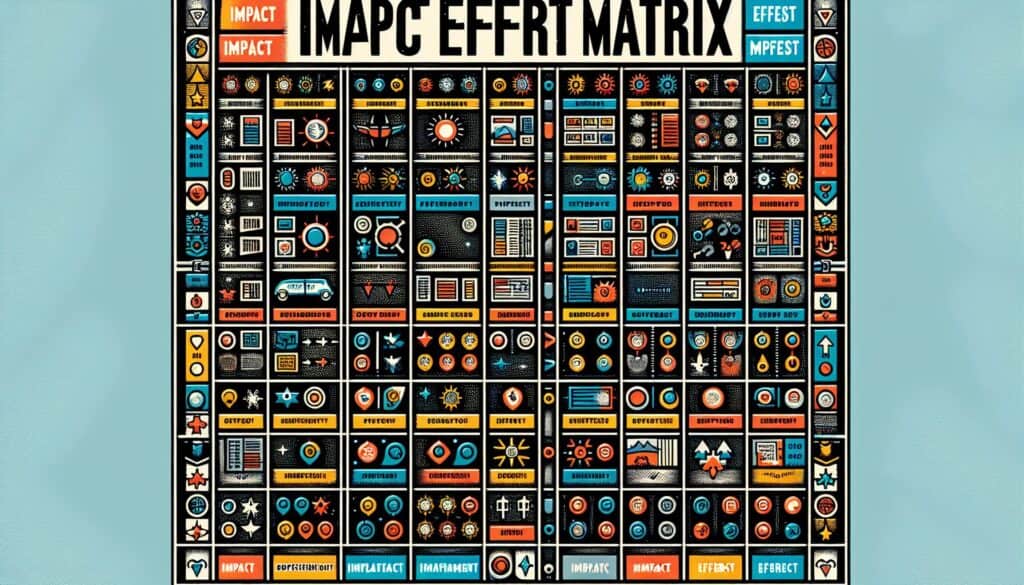To prioritize tasks or initiatives based on their potential impact and the effort required to implement them.
- المنهجيات: الهندسة, الجودة
مصفوفة الجهد المؤثر

مصفوفة الجهد المؤثر
- المنهجية الرشيقة, التحسين المستمر, التفكير التصميمي, التصنيع اللين, إدارة المشاريع, إدارة الجودة, سكروم, ممارسات الاستدامة, تخطيط مسار القيمة
الهدف:
كيفية استخدامه:
- A 2x2 grid where one axis represents impact (e.g., high/low) and the other represents effort (e.g., high/low). Items are plotted on the matrix to identify quick wins (high impact, low effort), major projects (high impact, high effort), fill-ins (low impact, low effort), and thankless tasks (low impact, high effort).
الايجابيات
- Simple and visual; Facilitates quick decision-making and prioritization; Helps teams focus on activities with the highest return on investment; Encourages discussion and consensus on priorities.
سلبيات
- Subjectivity in assessing impact and effort; May oversimplify complex decisions; Doesn't account for dependencies between tasks or strategic alignment without additional context.
الفئات:
- الأفكار, حل المشكلات, إدارة المشاريع
الأفضل لـ
- Quickly prioritizing a list of ideas, projects, or tasks to identify what to focus on first.
The Impact Effort Matrix is commonly employed in various industries including software development, product management, and engineering, particularly during the ideation and planning phases of projects. This methodology aids teams in evaluating potential initiatives by visualizing which tasks could lead to significant benefits with minimal resource investment, allowing for efficient allocation of efforts. In software development, for example, a team might identify user interface enhancements that could improve customer satisfaction significantly while requiring little coding effort, thus categorizing them as quick wins. Conversely, a manufacturing firm might plot a new product line launch that promises high returns but demands extensive R&D and market validation, positioning it within the major projects quadrant. Stakeholders from cross-functional teams, including marketing, design, and engineering, typically contribute to this exercise to leverage diverse insights and foster collective decision-making. The visual nature of the matrix facilitates discussions that can align team members on priorities, ultimately driving a consensus on which initiatives should receive immediate attention to maximize efficiency and effectiveness in project execution. This approach not only accelerates decision-making but also improves transparency in the prioritization process, ensuring that team efforts are concentrated where they can yield the most substantial impact.
الخطوات الرئيسية لهذه المنهجية
- Define criteria for impact and effort based on project goals.
- List ideas, projects, or tasks that need prioritization.
- Assess and assign impact and effort scores to each item.
- Plot the items on the 2x2 grid based on their scores.
- Identify and categorize items in the quadrants: quick wins, major projects, fill-ins, and thankless tasks.
- Discuss and prioritize actions based on the visual representation of the grid.
- Determine next steps for implementing the prioritized items.
نصائح للمحترفين
- Incorporate stakeholder feedback in the matrix creation process to align project priorities with organizational goals.
- Regularly update the matrix as new data or insights emerge, ensuring that your prioritization reflects current market conditions and customer needs.
- Utilize color-coding or tagging on the matrix for different team members or departments to visually represent responsibility and improve collaborative discussions.
لقراءة عدة منهجيات ومقارنتها, نوصي باستخدام
> مستودع المنهجيات الشامل <
مع أكثر من 400 منهجية أخرى.
نرحب بتعليقاتكم على هذه المنهجية أو المعلومات الإضافية على قسم التعليقات أدناه ↓، وكذلك أي أفكار أو روابط متعلقة بالهندسة.
السياق التاريخي
1960
1980
1983
1990
1995
2000
2010
1950
1980
1980
1986
1994
1995
2000
(إذا كان التاريخ غير معروف أو غير ذي صلة، على سبيل المثال "ميكانيكا الموائع"، يتم تقديم تقدير تقريبي لظهوره الملحوظ)














منشورات ذات صلة
جدول الإنتاج الرئيسي (MPS)
التخصيص الشامل
قمع التسويق
التدقيق التسويقي
مؤشر MAPO (حركة ومساعدة مرضى المستشفيات)
تخطيط موارد التصنيع (MRP II)